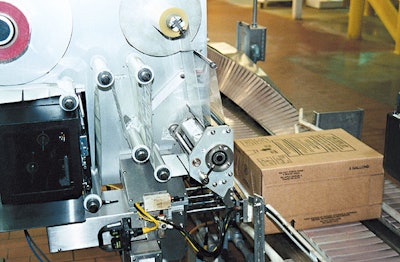Bag-in-box packaging lines for Coca-Cola concentrated syrup in five plants across the country recently got a labeling upgrade of the print-and-apply variety.
“The new labelers are installed in The Coca-Cola Company’s syrup plants in Dallas; Atlanta; Lehigh Valley, PA; Ontario, CA; and Columbus, OH,” says Coke’s Ray Crockett, media relations. “Installations began in 2001,” he adds, with the most recent taking place in Columbus this past April.
The machines selected by Coke are Model 410 Final Touch® tamp applicators from NJM/CLI. Integrated into each is a Zebra PAX3 thermal-transfer print engine. Another supplier making important contributions to the equipment is Rockwell Automation, whose Allen-Bradley SLC 5/04 PLC controls the print-and-apply process. An Allen-Bradley label-gap sensor with fiber-optic through-beam probes mounted to the peel plate ensures maximum speed and label registration accuracy. And the label feed roll relies on a servomotor for high-speed acceleration and deceleration, without which label registration could be compromised.
The new labelers are replacements for equipment that was nearly five years old. Coke selected three different machine builders and had each one install a labeler—built to “initial specs”—in one of two Coke syrup plants. After a three-month trial, NJM/CLI was notified that its machine had won the trial and that it should now build labelers to detailed specs.
Among the requirements was what NJM/CLI calls “dual-reel capacity.” In other words, the machine had to be capable of feeding from either one of two 14” label reels so that operators could switch from one flavor’s label to another in a matter of minutes.
Other key requirements sought by Coke were speed and reliability.
“The equipment is capable of printing and applying more than 100 labels per minute,” says Crockett. The labelers are also durable, he adds. “We’ve had great reliability from both Zebra and NJM/CLI. For our application, they have performed very well. Improved line efficiency, less equipment downtime, and reduced maintenance costs have been gained since the machines were installed.”
The 3”x6½” p-s paper labels are applied to the end of each case. Information that’s printed includes product name, description, lot number, and a bar code used in Coke’s distribution system.
And the payback on Coke’s investment?
“We’re very pleased with the payback, but we’d prefer not to release figures,” says Crockett.



















